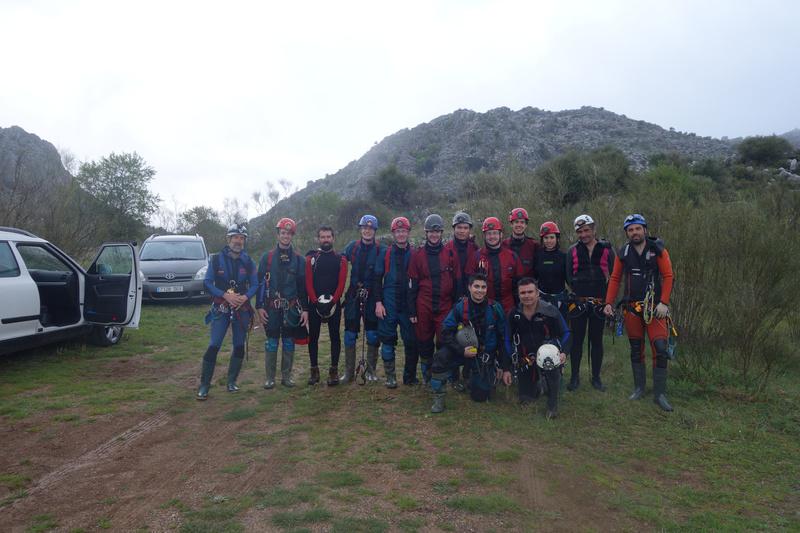Andalucia Easter Tour
Arun Paul, Catalina Garcia, Jack Hare, James Perry, Kenneth Tan, Peter Ganson, Rhys Tyers, Sam Page, Tanguy Racine
Thursday 7th April 2016
The waking up was rough, as voices echoed along the corridors of stores, filled with enthusiasm and the accents of an all-nighter. It was about 3am. There was a short session of last minute repacking, weighing, equilibrating. By 5am, we were outside Gloucester Road’s Holiday Inn, waiting for the shuttle bus to take us to Gatwick Airport. By about 8am, we were ambling through the duty free to the boarding gates, mildly worried that Catalina was lost. We all made it to the plane and settled in for the 2.5-hour flight to Malaga, Malaga, Andalucía, Spain.
We arrived in the bright Mediterranean sunshine, and promptly found the hire car shuttle vans. In two teams, we reached the offices of the car hire company and Jack retrieved the keys of the two cars he’d booked: Bismarck, a large diesel automatic seven seater, and a smaller manual five seater, Manuel. My group, Sam, Peter and Perry and I drove north towards Antequera, then west, circumventing the Sierra de las Nieves to our left, before heading towards Ronda, and further west to Grazalema where we would stay for the week. The other team took the coastal road, south of the mountain chain, then headed north towards Ronda. Due to a combination of stops, hairpins and slow lorries, both cars arrived at the destination within 15 minutes from each other, after an almost 3 hour journey. The dry vegetation of Malaga gave way to the greener pastures of Cadiz, and the Holme oaks replaced the cacti and olive trees of the plains. Everywhere, the crags of grey limestone overlooked the rolling hills. This was caving country if ever there was one!
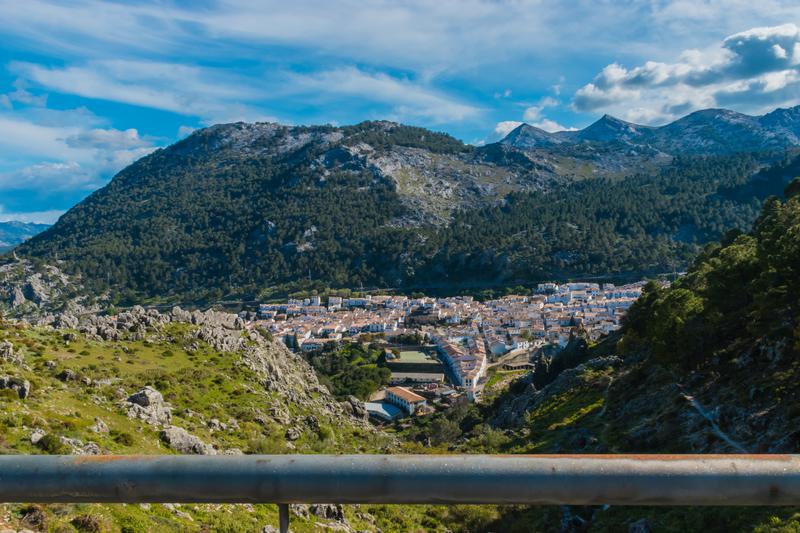
After settling at the villa in Grazalema, a splinter group drove back to Ronda to shop at the Aldi with the most breath-taking car park panorama. Back at the villa, vast quantities of wine (some of which lacked labels altogether) awaited us. Don Simon, which had already been rated as ‘good when inebriated’ three years ago made it back to the table. So did a good amount of rich food, in preparation for the morrow’s trials: Sima del Cacao.
Tanguy
Friday 8th April 2016
The sky was clear as a sapphire, the morning light crisp and white etching the limestone crags against a sea of blue. The first caving trip needed to give everyone a taste of Andalucía caving, and I had got permits for Sima del Cacao, which promised so good SRT and a payoff of good formations at the bottom chambers.
We drove out of the mountain village towards Villaluenga del Rosario, twenty minutes away on the idyllic road of the Andalucian network {very good asphalt, if a little narrow in places). Snaking our way at the bottom of the valley, we soon reached our destination, and parked on the designated area, facing a cheese museum. To the west lay a steep 300m ascent to the karstic plateau where the entrance to the cave was found. We started from the Arena Plaza, crossed a gate to reach a subtle path winding up and followed it up a narrow gully. At the top, we chose to cross the barbed wire to our right to reach a grassy plateau to the northern edge of which a path led off toward the cave entrance, following a contour. In the midst of fallen blocks and barren clints, an opening!
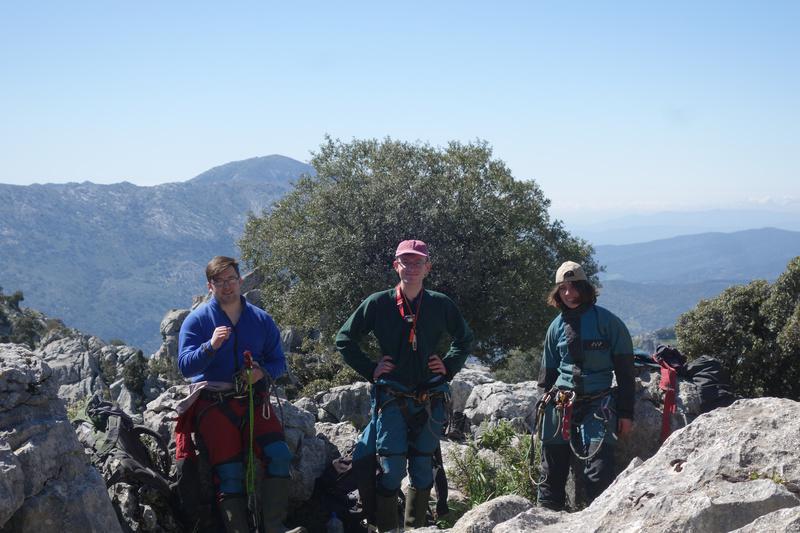
There were two possible entrances, the larger was adorned by a shrub with two approaches. From the south, it was possible to wrap an extended deviation (we’d brought the hypersling fortunately) around the thickest branch. Rigging the northern route was easier so I proceeded to do that, used the deviation placed earlier and plunged into the depth of the first pitch. At 80m, and completely vertical, it was essential to spot the rebelays that fractionated the descent, and to spot everyone of them. I found the first pair of spitz easily enough, but after descending to the end of my rope, without reaching any obvious ledge, I concluded that I’d missed the following ones. On the ascent I found a few more and rigged them. I soon reached the stopper knot of my first rope again. I called for more rope, which Kenneth handed to me over a rebelay and carried on, to another rebelay until I saw a ledge opposite me. The way on was through a window, after a traverse mid-way down the pitch. Swinging into the wrong window had been the turnaround point of the previous exploration by the 2013 party. Unfortunately I repeated the mistake, no doubt eager to step on firm ground again. Jack and Kenneth followed, with the remaining rope.
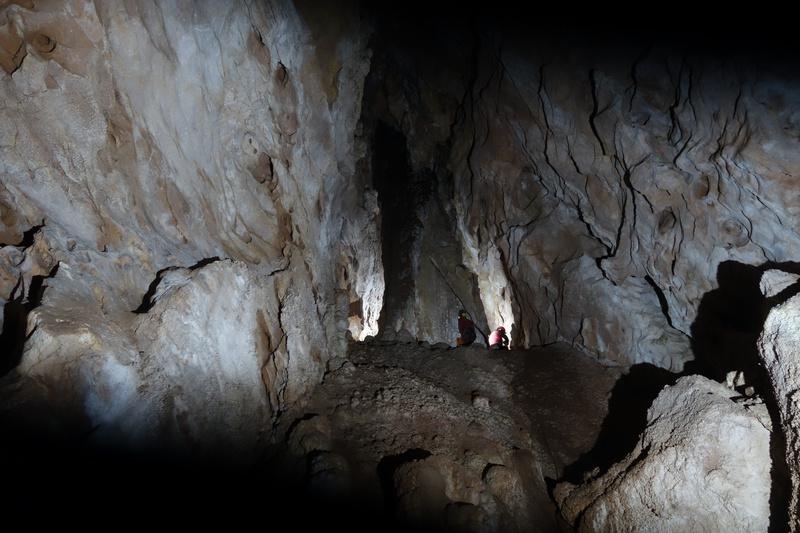
I was almost tempted to turn around. It had been a couple of hours on the rope, with nothing but hostile, smooth rock for company. Jack persuaded me to continue when, looking across the pitch, the correct window, slightly lower down could be seen. Shining my spotlight at the rock face I tried to make out the possible route down, and around the corner to the window.
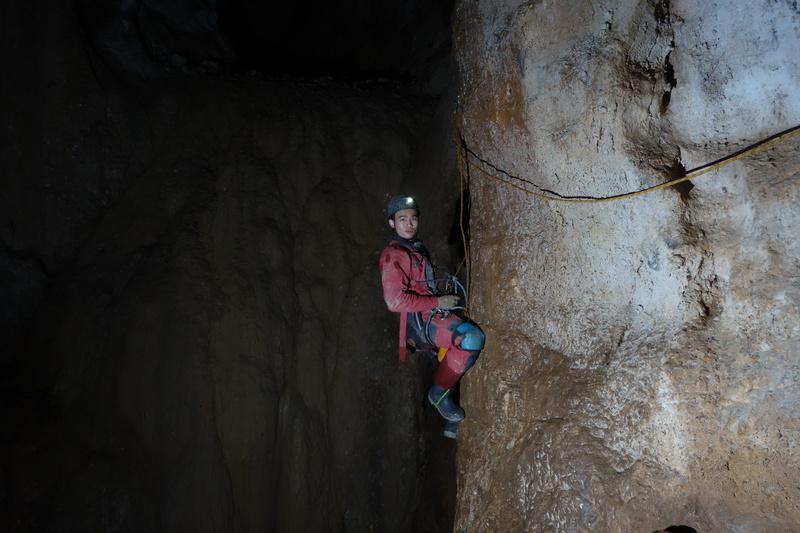
I ascended to the last rebelay, rigged a third rope, and suddenly, all the hidden spitz and P-bolts appeared under me, indicating the way. One by one, I rounded the corner, and reaching with an ultimate burst of energy, clipped into the P-bolt at the window. Then followed the others, Kenneth, then Will, Jack, Perry, Catalina, Arun, Peter and Rhys. I exhausted my remaining rope on one last descent, over a calcified slope. We came together the bottom, where organs and stalagmites dappled in the different lights seemed almost alive, and after a snack it was time to go back to the surface.
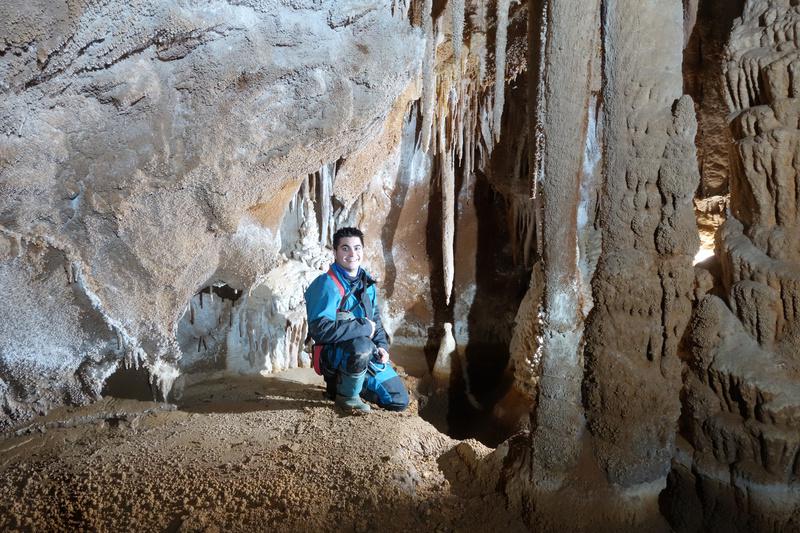
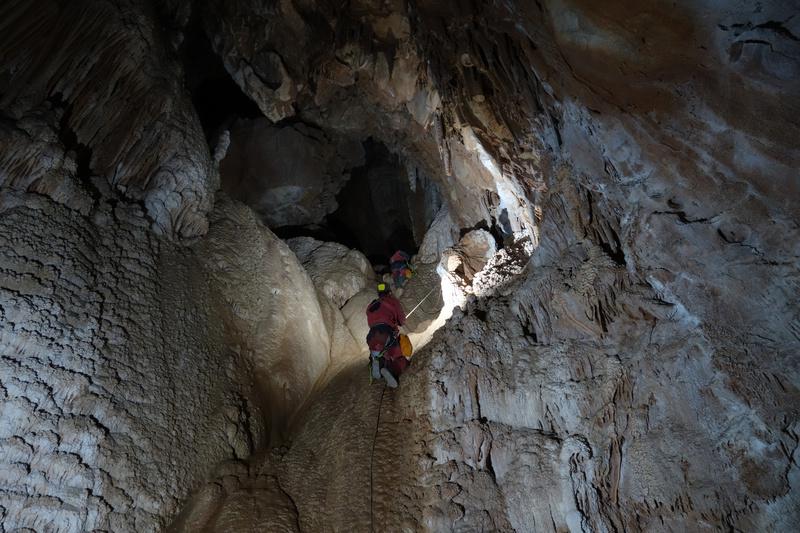
As I stepped out of the window, and traversed around the corner to begin the ascent of the entrance pitch, I noticed that the mid-afternoon light reached all the way to the bottom. Nearer the top, it was possible to look down on the drop, with the lights of four cavers ascending. The ascent was without glitches, save when Perry saw fit to push his ascender in contact with the knot above. This was resolved soon, and the climb out continued.
It was decided that the first four out would run down the hill and drive Manuel back to Grazalema to start cooking dinner. Perry, Catalina Sam and I therefore found a direct way down to the car park and hurriedly started peeling large quantities of potatoes for a fry-up. Thanks to the combined efforts, four frying pans were soon singing in the kitchen and the thought of buying beverages from the nearby supermarket crossed our minds. I sent the following message to the other party, who by now were down the hill: ‘Dinner ready, out in the town to buy drinks’. All four left the villa and took the key, aiming to be back before the horde of tired cavers came back to knock on the door. This did not happen and I picked up a call from a somewhat irritated Jack. Sam ran back to the house with the keys and I carefully avoided the impending ire. The hearty meal soon put every right, while many and more bottles travelled from hand to hand.
Tanguy
Saturday 9th April 2016
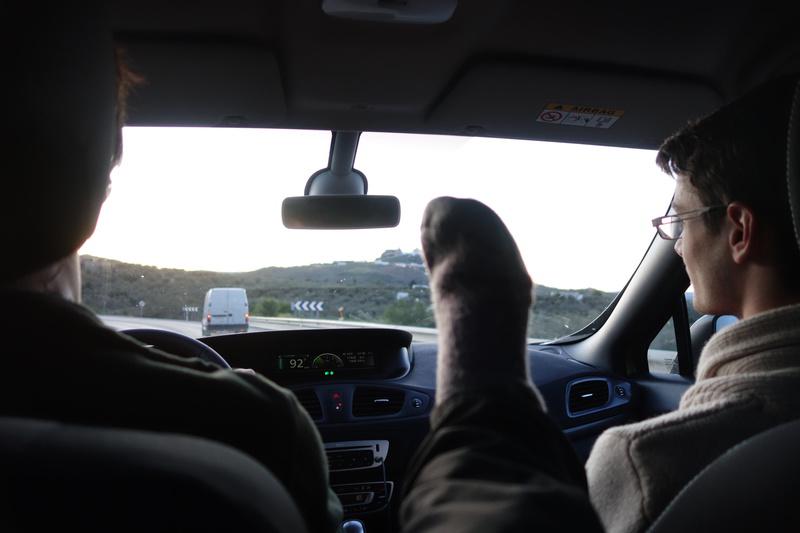
This day the group split between the Cabra explorers and the Via Ferrata wanderers. The crack team left Grazalema before dawn to drive two hours to Cabra, in the province of Cordoba. This was to the northeast of the Sierra de Grazalema, in the sierra Subbeticas. We were treated to a colourful sunrise, rolling mists and mostly empty roads. In Cabra, we agreed to meet local cavers of the GEAL (Gruppo Espeleologico del Aire Libre), in particular José Ballesteros, who’d shared a drink with us back at the Union on the preceding Tuesday. After a short wait in the car park of the municipal sports centre, we joined the other group who picked up a few ropes from their own stores.
José then asked me what type of car we had, no doubt to verify it could handle the rough tracks to the cave. I blithely replied that its colour was ‘taupe’. Now he would be sure not to lose us on the way.
We left the town of Cabra, and headed into the hills on a gravel road, up and down through the olive trees. After ten minutes we came to a halt on a small platform, manoeuvred the car around and stepped out to get changed. There followed a short walk to the cave entrance, described in Cervantes’ Don Quijote. A carved stone from 1905, and a memorial plaque dating from 2005 commemorated the tri-and quadri-centennaries of its publication.
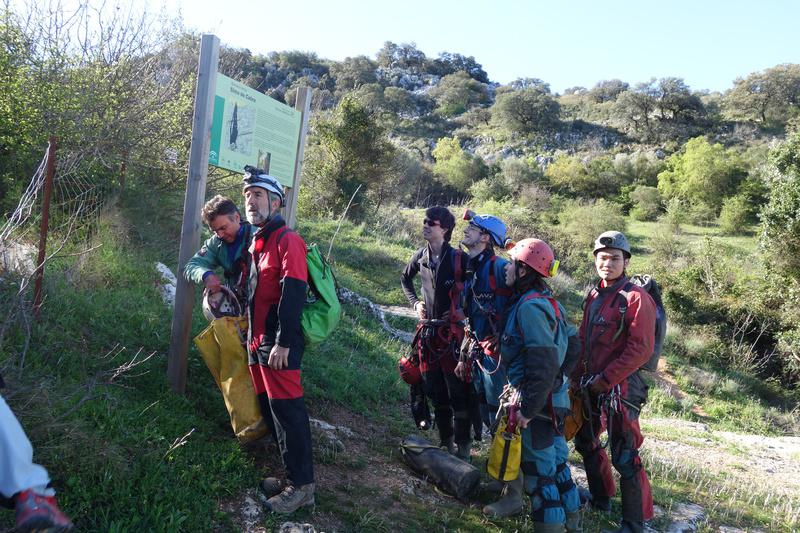
The cave was one single 120m deep pitch. Two ways down had been pre-rigged, so this was the occasion for each caver to practice their rebelays, cope with vertiginous depth and perfect their prussiking. One route in particular landed on a saddle (the Canales ), before leaving the main pitch for a small escapade in a side shaft. Quickly the main shaft was regained as the floor disappeared underfoot. The landing on a large heap of ‘matter’ completed the descent. Left and right, there seemed to be dark corners and recesses that the GEAL was actively exploring. Far up, a triangular piece of sky let in some light, while the sound of pigeons above resonated like the soft thrumming of fingers on a drum.
It was soon time to leave, and by two o’ clock, all were out, drinking the sunshine by the gaping entrance. From our vantage point it was possible to look west for a hundred miles, all the way to Sevilla. With the caving done early, we opted to drive back to Grazalema to start another activity. We arrived there at around 5 o’clock, before the Via Ferrata wanderers, therefore had to wait outside.

I wanted to hike in the nearby mountains, having previously looked up a route to the Endrinal massif, south of the village. Kenneth was game for a quick walk up so we left the town and took a very popular craggy mountain path up, crossing an uninterrupted torrent of mainstream hikers. We reached a col where the routes back to Grazalema , and further on to Villaluenga parted. Carrying on south, we dropped to a small blind valley, the Llanos del Endrinal. It was a green polje once used for growing peas in a mountain fastness, now dedicated to the grazing of a few bovines. After the flat green grass gave way to a forest of oaks, we started climbing again, towards the fragrant expanses of wild thyme and rosemary high above, and further still where white bare rock reigned supreme.
With the clock ticking, we stopped in a small prairie to have water and turned round. It was a quick descent to the polje and from there only three quarters of an hour to reach Grazalema, where a warm meal awaited us.
Tanguy
Sunday 10th April 2016.
There was a strong sense of excitement at the prospect of exploring a river cave with the local cavers. We had agreed to meet Manu Guerreros at a Venta near the El Gato entrance of the Sistema Hundidero-El Gato early in the morning. It emerged this was so we could gauge the water levels, especially since it had rained a lot during the night, and the forecast for the catchment area looked dire on the day. There was too much water to traverse the system, but we would explore the upstream entrance nonetheless, and climb into newly discovered galleries for some.
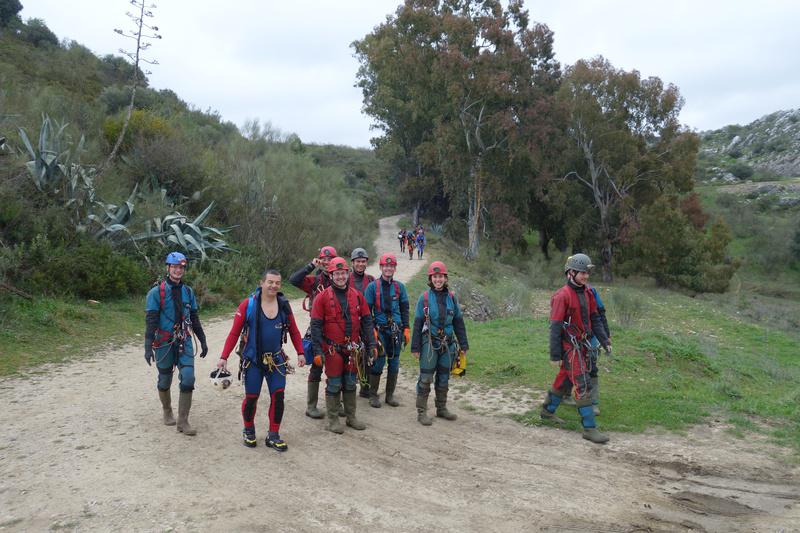
Manu and his friends drove off and we followed, past the towns of Benacoaz and Montejaque to a parking stop at the western end of the massive limestone unit where Hundidero entrance lay. The path to the cave wound inside a large depression with sheer cliffs on three sides, and a dam on the fourth. It was empty. Manu explained that it was a poorly engineered project, since the dam would never fill up. The cause lay right before our eyes: the water flowed through the cave, like the sieve of the Danaids.
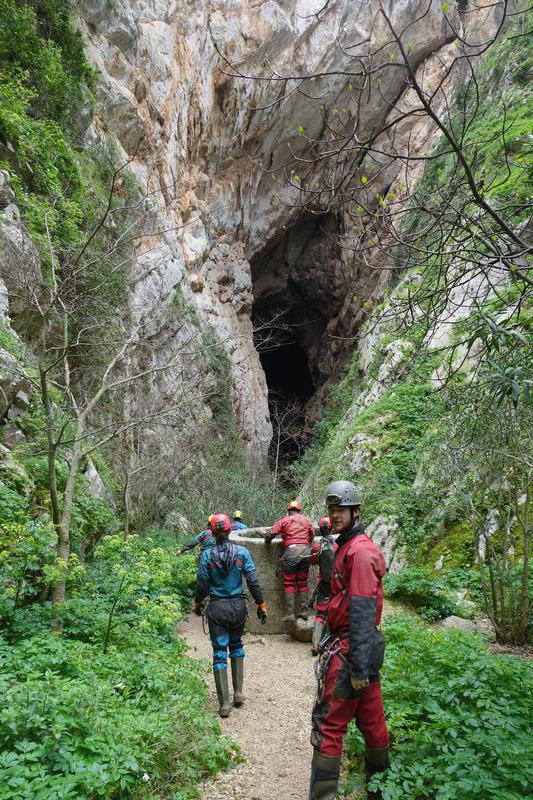
We descended deeper inside the space that would otherwise be underwater, till the entrance proper rose before us, a high vault, maybe seventy metres high, getting bigger inside. It was almost a case of not knowing when exactly the cave began and the gorge stopped. Wherever the drizzle stopped looked like a good boundary. The entrance chamber, of truly vast dimensions was boulder strewn but a flight of steps carved in the stone guided us. Soon Manu came to a stop, where after a small climb down into a knee deep pool the stream dropped a further five metres into a lake. Here he put up a sign stating ‘exploration in progress’ and rigged a rope for those who wished to descend into the lake. The others could very well jump it.
I agreed to do this, along with a few other hardy cavers, carefully putting my glasses away before taking the leap. I found my gear to be very buoyant and swam to the nearest shore. Afterwards I followed Manu’s lead across the chained traverses and deep pools one had to swim through. Looking up we started glimpsing the remnants of tibetan bridges, planks of wood dangling from steel cables and steel rods jutting out of the walls above. They once supported the weight of mules laden with equipment, led inside the cave to the sites of dam building. Whenever a way was blocked the water found another. The cave never filled up, and the project was abandoned.
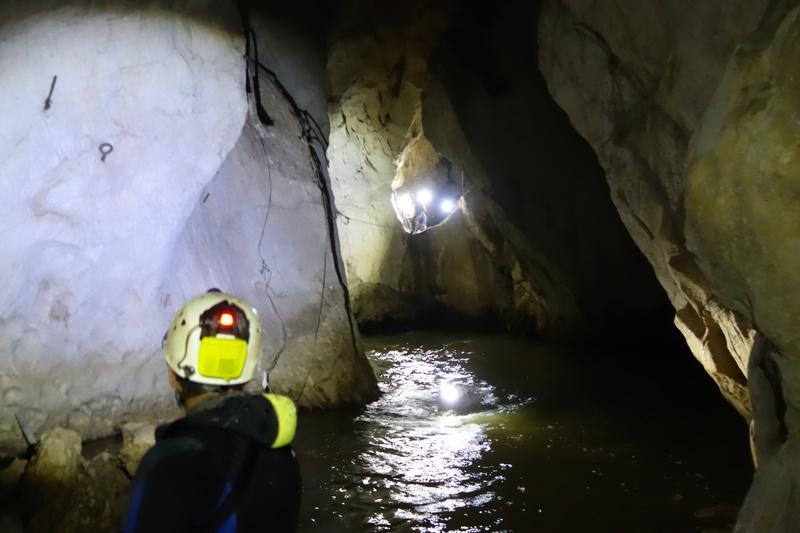
After another few deep blue pools – some of which had been dived successfully, we reached a sand bank where a rope could be seen going up to higher galleries. Due to the size of the group, only a handful could explore the newly found passages at one time, while the other group would push downstream further. Kenneth, Rhys, Jack and I ascended after four other Spanish cavers and Manu agreed to take the rest of our group further downstream.
I started the ascent, noticing the very tight exploration rigging: the rebelays were almost exclusively placed where a rope had obviously run short. At least one rebelay knot was definitely a hitch. At the top of the rope climb, there was very exposed traverse underneath jammed boulders in order to reach a calcite climb. This turned into an old empty gour pool which provided a balcony over the large gallery. Further on, the gour pools bridged the width of the passage. At the bridge there were two obvious ways on: one back along the wall we’d just ascended and then into a perpendicular passage, dry, covered in speleothems and guano. At the end of this extension the four of us stopped for a small photo session before doubling back to explore the other way.
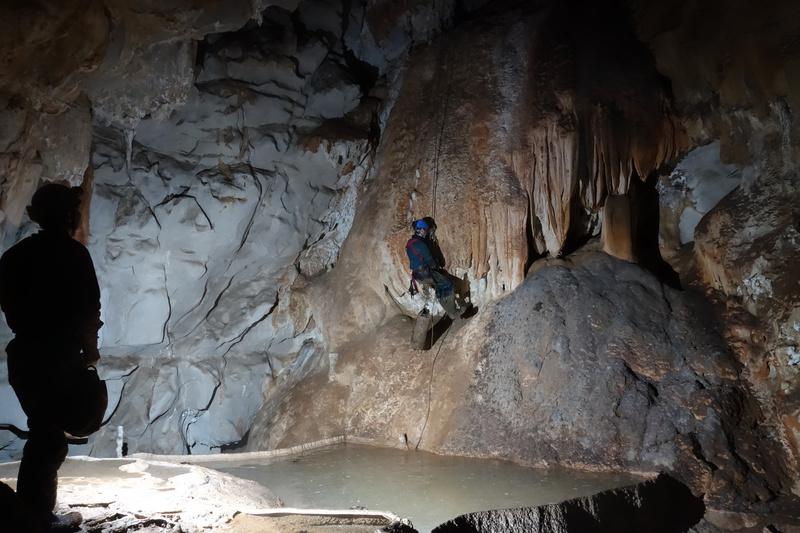
We crossed the bridge, wading through a muddy gour pool and ascending on a flowstone to another gallery. This ended in a muddy, wet, decorated alcove found at the top of a calcite climb. Turning back, we descended the incredibly tight rigging using various techniques, from a ‘protected free-climb’ approach to ‘down-prussik’. Neither was deemed graceful enough to become the adopted standard.
At the chamber we discovered that Manu’s group hadn’t come back from their own exploration yet. Jack and I followed José and two other cavers the way they’d presumably gone. After a downward climb, a rope descended into a pool of water. Lights bobbing up and down, and lots of quickly spoken Spanish, with the odd grunt. Perry’s face appeared, haggard. He muttered a few words trying to step to the pitch head. He was very cold and tired he told us. So was Sam. Peter and Arun seemed fine, Catalina was ecstatic. We heard about a long expanse of water where they realised they’d bitten off more than they could chew.
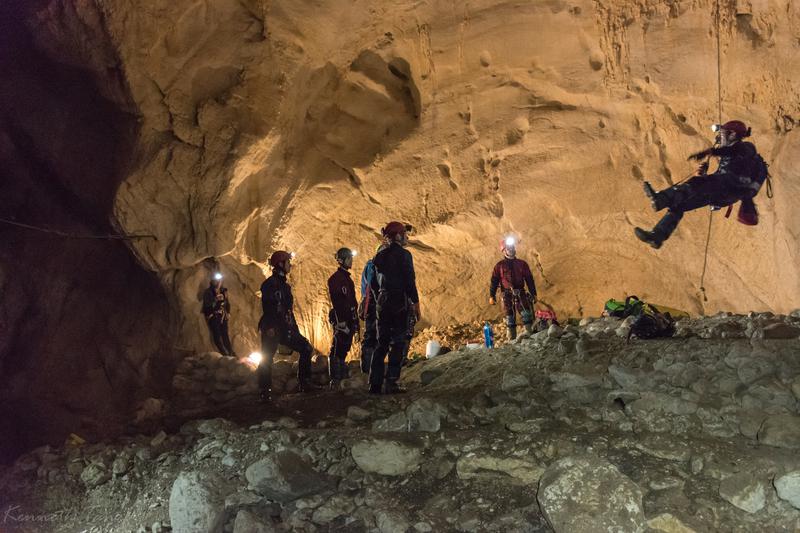
Rhys and Kenneth joined us at the pitch head and soon we were all together, discussing the plans. Jack volunteered to help out with the cavers heading out of the cave. Rhys and Kenneth agreed to do the same. I chose to follow José and the other two Spaniards further down into the cave. As a smaller group we moved downstream, descending two or three climbs, marvelling at a very impressive gour-pool formation before hitting the long lake. Because this was almost directly connected to the surface the water here was a little warmer, and the crossing went ‘swimmingly’. Past the lake we entered the Plaza del Toros, a truly massive cavern, with large windows leading upwards. There were still more artefacts of the dam building endeavour. Further downstreams a large inlet joined our streamway, turning it into a churning mess, not a place to be in floods.
We turned around here and after a steady cruise back to the entrance we started hearing the sounds of the other party’s voices. There were flashed of light, no doubt Manu and his camera apparatus. I joined up with Kenneth at the entrance cavern as he hunted for the perfect shot of this enormity. There was a little drizzle as we came out of the gorge and soon we were back at the cars, sharing the homegrown oranges kindly offered by one of the cavers.
On the road back towards Grazalema we stopped at another Venta to eat tapas and drink a hot chocolate. The discussion turned to our next trip: we wanted to cave in the Sierra de las Nieves, east of Ronda, enter quite high up, and camp overnight in a newly explored cave. However as we got more and more details on the logistics, and the incoming weather it became apparent that it wasn’t advisable: we’d be on our own looking for a cave entrance we’d never seen, in the middle of a cloud. Instead, Manu proposed to lead us to the entrance of a cave lower down, in the same massif, Sima Mones. I committed a group of imperial cavers to doing this cave on the morrow and we siad goodbye to the Spanish cavers.
Tanguy
Monday 11th April 2016
The weather did not look promising but it wasn’t a deluge, so Jack, Kenneth and I drove off to a Venta near Sima Mones to meet with Manu. After a coffee, Manu showed us the 10mm bolts needed to rig the cave, agreed to lend them to us for the trip and gave us instructions on how to give the metal back. He wen to his car, and we followed him, leaving the Venta. We drove off the road onto a gravel path, through the olive trees and began winding our way up the mountainside in the mist, sometimes glimpsing the valley floor underneath when we emerged from a patchy cloud layer. Half-way up the gravel gave way to smooth asphalt, which was disconserting, but sure enough we were reminded that the EU had spent a lot of money to upgrade the andalucian network.
At a layby we got changed in the chilly air – it had fortunately stopped raining. After a few minutes Manu led us up the hillside, through the shrubs till a small goat’s path was found. He pointed out a saddle as a very important landmark on the way back, and after what seemed like a little hesitation found the entrance. He entrusted his metalwork, and a two-diameter spanner to us, and promptly walled off into the cloud, waving his hand, his umbrella vanishing last.
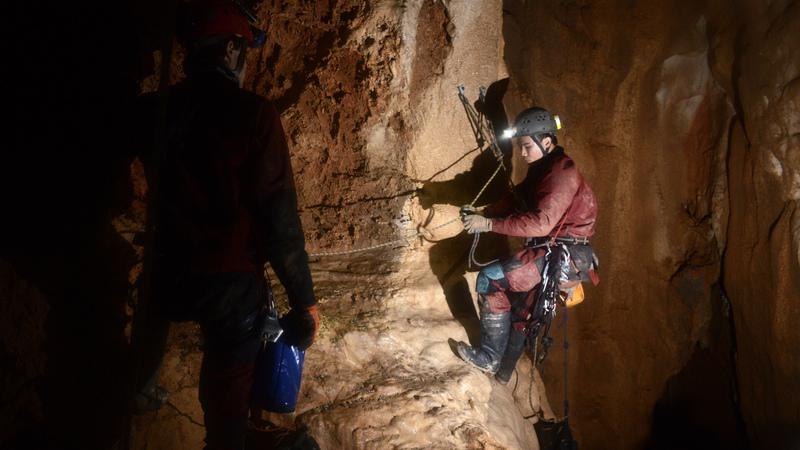
I quickly rigged the first hang to get out of the adverse weather, and soon found my way to the head of the second pitch. It was found at the top of a calcited ramp some 5 metres above the bottom of the pitch. The entire drop was within a flowstone, earning the name ‘Pozo Blanco’, or white pitch. Three rebelays later I touched the floor of this pitch and headed into the sharp, cosy rift that lead to the next drop. We sent Jack to grab the last bag of rope we’d left on the surface while I continued rigging. The next pitch belled out at the bottom and was somewhat larger. I landed on a ledge and waited for Kenneth to come down so he could have a go at rigging. By that time Jack had rejoined us, so we settled for a quick lunch on cheese and dried sausage before carrying on. Kenneth took the metalwork and set about rigging the route.
There were a few more drops before reaching the final chamber, whose walls were very yellow, covered in abundant calcite blobs. We knew this was the bottom of the cave, but still spotted a possible window a third of the way up the final chamber which Kenneth had fun climbing and I swinging to. Jack volunteered to derig, so I headed up in front. I waited at the last rebelay, with Kenneth just underneath at the second to last until Jack was very close, and we all got out within minutes, packed the remaining ropes and walked down back to the layby.
This was easily found for the clouds had cleared off a little, and we made our way back to the villa in good time for a hearty meal of couscous and a game of Saboteurs.
Tanguy
Tuesday 12th April 2016
The weather outlook was dire, with Grazalema in the centre of a localised perturbation. The clouds hung low, and often a curtain of heavy rain would follow not-so-heavy rain. We had no plans for caving, but I wanted to get out nonetheless and maybe walk. Perhaps somewhere else the sun still shone. We decided to visit the entrance to Sima del Republicano, located at a sink of a river flowing within a large polje. The resurgence was 14km away to the south.
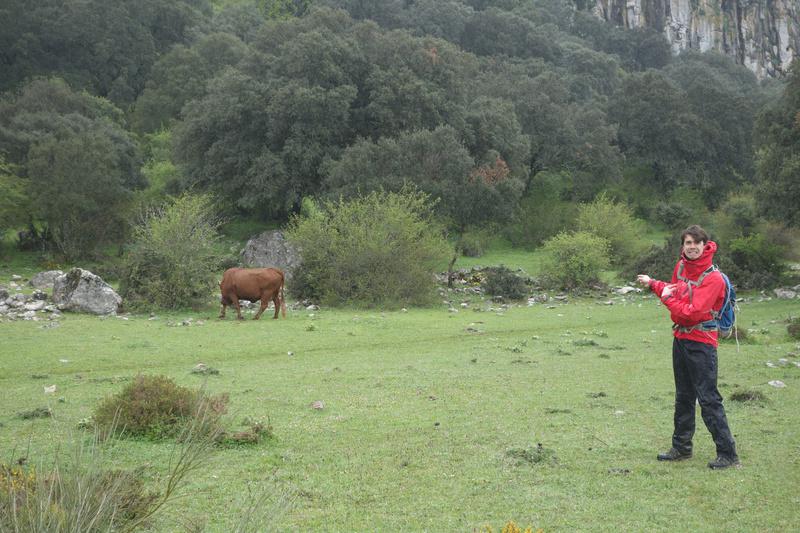
We parked in Villaluenga del Rosario, where there was only slight drizzle and low cloud. The walk began as an ascent to the cloud base towards the east before dropping down into the polje proper. Amidst hills of grassy pastures there lived a beautiful breed of bovines. The entrance was properly indicated and lay at the foot of the next line of limestone hills, within a large jumble of smooth weathered boulders. Satisfied that we had achieved our purpose we turned around there as the weather turned to a fiercer rainfall, soaking through all our layers. Back at the cars we quickly drove off to seek the blessed warmth of the villa where we stayed a few hours deciding what to do next.
Jack proposed to visit the Cueva de las pilates [Cueva de la Pileta], a nearby show cave which had had a good review from Mendip cavers a few years past. Seven of us agreed to go, and we drove past Montejaque to the cave entrance. There we waited three quarters of an hour for the next guided tour. Inside the cave we were given lanterns, which forced us (rightly so) to look at what the guide was describing. This also enabled a few reveals of parietal drawings, ancient water lines and oddly shaped formations. In the innermost chamber, our leader stamped his foot on the floor to demonstrate the small amount of rock that lay between us and a lower chamber, the rock resonnating with the impact. This cave, we learned, also hosted an endemic species of ‘waterworm’ in one of the isolated ponds we crossed. Other ponds in the same cave had proved to be barren.
Tanguy
Wednesday 13th April 2016
I had acquired permits for a day out canyoning in the Garganta Verde, a limestone gorge to the north of Grazalema. The weather however had not improved, and by the time we arrived at the layby we wanted to get changed at, it had even deteriorated, making both the hair-pin road and the descent to the canyon precarious. We carried on to Zahara, where we hunted for a café, to pass the time until a sunny spell. Mid-morning it arrived so we drove back up to the lay by, dropping off the majority of cavers, while the two drivers went to the exit of the canyon to park one car. The rest of us waited and familiaried ourselves with using the piranha.
We were surprised to see both cars coming back up to us, but the explanation came quickly: the access road to the downstream end of the canyon was very steep and in danger of turning into a mudslide. They had cautiously back tracked and given a lift to two canyoners on their way up to the start. As if to comfort the reasonable decision, the rain started to fall in sheets and the surrounding mountains disappeared again in a grey cloud. We opted to go back to Grazalema via the precipitous mountain road and regroup there to decide further actions.
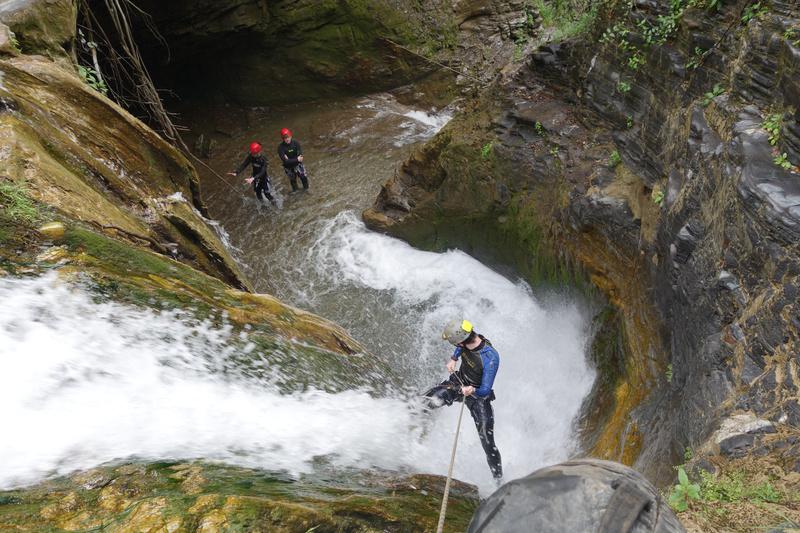
At the villa we discussed the possibilities of canyoning elsewhere and settled on the canyon ‘Sima del Diablo’, situated in Juzcar, a village that had traded its traditional white coat for a ‘smurf blue’ look year ago for the filming of one of the franchise’s films. It was a little more than an hour’s drive there but we were assured by an untrustworthy weather application that it never rained there. Upon arriving there, the last shreds of belief in any forecast were stripped away from us: there was some sad drizzle, and the blue of the walls had obviously started to turn to a bleached shade.
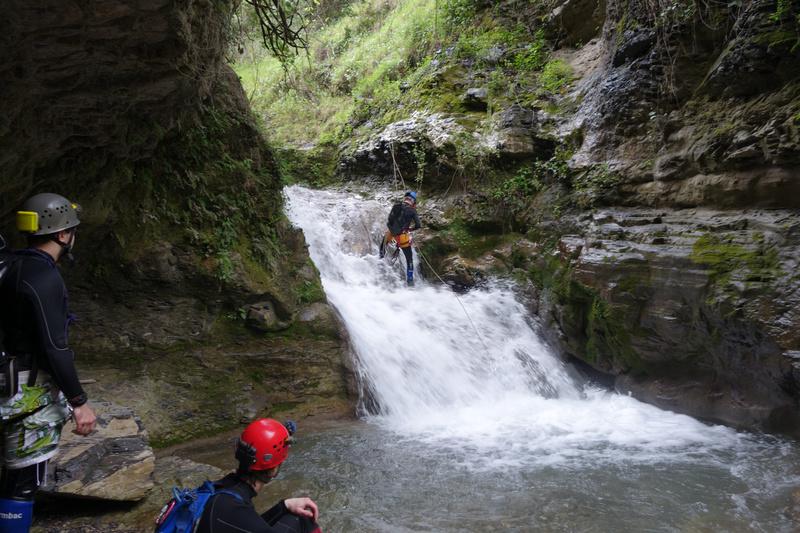
Nevertheless we got into our gear and followed the blue arrows to the start of the canyon route. It began as a rather calm torrent, with the odd climb down, no more than knee height. We hit the first rappel towards the middle of the route, and, after Jack demonstrated the correct technique for placing the rope, we headed down the 4m drop. It was very entertaining. Rhys and I then left the group to start rigging the second drop. This was found very quickly, a larger 10m rappel this time in a pitch that wrapped around the waterfall. I let myself slide towards the bottom under the force and declared the rope free. Rhys followed, and one by one everyone descended. I pulled the rope through and carried on downstream. Jack had already rigged the final drop when I arrived and soon all were merrily splashing along to the end of the canyon.
All in all it was a short, easy introduction to canyoning, but probably a good one to start with. Four of us opted to do it again before heading back to the villa for our final night in Andalucia. The meal consisted of beef burgers with patata harra in lieu of chips, which sated everyone and messed up the kitchen. We drank to the completion of a successful trip before thinking about the morrow’s plans.
Tanguy
Thursday 14th April 2016
The flight’s were booked in the evening, leaving us plenty of time to first clean the house, and have some sort of nice activity en route to Malaga airport. We first stopped in Ronda to try out some Via-Ferrata for those who hadn’t done any yet. We descended (one is not meant to descent a route, it is known) the first easy route and ascended by the Ronda bridge, on the eastern wall of the canyon. The city was packed full of tourists and the weather gloriously sunny.
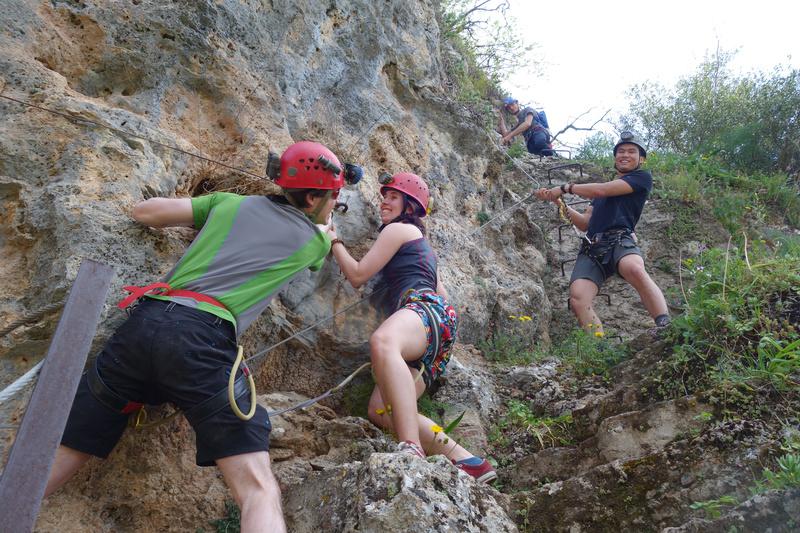
After this, one group decided to take Manuel to Marbella and find a spot by the beach to relax, while another chose another itinerary south, going past some of the via-ferrata towns we’d gotten information about. We halted in Benadalid (if my memory serves), got the GPS out and figured out the route was not in the town, rather a 30 minute walk to the base of a large crag, followed by a good hour of climbing. Although the view promised to be spectacular we didn’t have enough time to make it happen. We reluctantly packed up our gear and drove south, always south until we left the mountains altogether.
We found ourselves taking the coastal motorway towards the east, reached Marbella and met up with the other party. Some had a small dip in the water while others relaxed on the warm sands, collecting seashells. Soon it was time to bid adieu to Andalucia and continue our journey back to the UK.
We arrived at almost two o’clock in stores, and having no desire to meander around the public transport I put my sleeping bag out and chose to spend another night in the company of mice.
Tanguy

